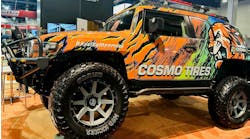Pop quiz: list the top qualities consumers seek when purchasing a new set of tires. Is green technology anywhere on that list? Plenty of Modern Tire Dealer readers say it’s not.
A year ago MTD surveyed dealers about their green — or “eco” — tire sales, and the results were staggering. Fifty-eight percent of dealers said green tires — those that tout low rolling resistance and other fuel-savings qualities — amount to just 5% of their consumer tire sales.
Yet, manufacturers constantly are developing “greener” products, in large part because original equipment fitments depend on it.
But the government’s environmental demands on auto manufacturers haven’t (yet) trickled down to the everyday driver, and dealers say consumers either aren’t buying into the idea of green tires, or simply don’t know a thing about them.
“Over all the tires that we sell, I could count on my hand in the last 10 years how many people have come in and asked for a tire with green technology,” says John Jindra Jr., the store manager of Quality Tire Service in Johnsburg, Ill.
“I’ve been in the industry my whole life. People today aren’t really buying the green technology. They’re basically looking out for their dollars. How long does it wear? How does it handle?
“We made a mistake and put standard tires on a vehicle where eco tires were stock on the vehicle. It decreased the vehicle’s fuel mileage, but increased traction, handling, ride and tread wear. The customer was happy to give up a small change in fuel mileage to receive the difference in the other, better features of the tires.”
Jindra is just one of the dealers who responded to last year’s survey, and his concerns match those shared by other dealers. More than half of the dealers who offered comments had something negative to say, calling green tires “hype,” “slow movers” and a “non-factor” in their business.
David Ross, owner of two Ross Tire and Service locations in Louisiana, says, “Green has not been a real factor. We don’t have people coming in and saying, ‘tell us about your green tires.’”’ Instead, Ross says customers are looking for long tread life.
Yet a March survey commissioned by Bridgestone Americas Inc. indicates Americans are still focusing on fuel efficiency. The survey of 2,000 adults in the U.S. asked respondents what they’re doing to make their money go farther. Ninety-four percent were looking for ways to stretch their money, and 74% of vehicle owners had made changes to their driving habits and performed vehicle maintenance in the previous year to improve their gas mileage. Respondents’ top three fuel-saving tips were to combine errands, maintain tires by checking air pressure and tread, and avoid sudden acceleration and stopping.
Mike Leverington, general manager for Aeolus Tire America, acknowledges the green tire can be a tough sell. “It is difficult to demonstrate some of the benefits to consumers on the retail floor.
“Many dealers that I have talked to in the past are not committed to the green tire in their own mind set, and often have difficulty convincing customers of the benefits,” Leverington says. “The impact of green tire benefits may seem small to some, but as an aggregate it starts to make a difference, especially with the improved rolling resistance which provides 3% to 5% improved fuel mileage and less carbon emissions.”
Not every manufacturer is pushing the green message, however. Michael Mathis, co-owner and vice president of international marketing for Atturo Tire Corp., says green is a “non-factor” to consumers of the company’s SUV, CUV and LT tires.
“I cannot think of a single instance of this being a consideration in selecting a tire by a consumer,” Mathis says. “Our owners are more interested in grip, which is the inverse of low rolling resistance, and noise, than rolling resistance.”
Atturo has improved the rolling resistance of its products, however. Mathis points to the AZ850, which features a 28% improvement in rolling resistance over the AZ800. Still, when consumers shop between those two tires, Mathis says the uptake of the AZ850 “has been minimal compared to the lower-priced AZ800.
[PAGEBREAK]
“Buyers of the AZ850 are more interested in the other performance characteristics of the model. I actually think if we pushed the lower rolling resistance, it would be a detriment to the product!”
Mathis points to the European tire labeling rules, which require passenger, light commercial and heavy commercial tires be labeled and rated for fuel efficiency, wet grip and noise.
“It seems that even having the information forced upon consumers has not changed their buying habits,” Mathis says. “I believe this is a case of a forced push by regulators and a few in the tire industry trying to create interest and differentiation on a subject which is generally not a consumer priority.”
In the MTD green tire survey a year ago, two complaints were especially prominent:
1. Green tires are a three-season product. They simply don’t perform well enough in the ice and snow to satisfy winter-climate customers.
2. Customers aren’t aware of or knowledgeable about green tires. Dealers say tire manufacturers need to do a better job educating the public about the technology. The green tire sales pitch is dead on arrival when customers are completely “green” on the subject.
MTD took those concerns back to the manufacturers. Here’s who responded:
- Robert Saul, senior product manager for Bridgestone Americas Tire Operations
- Sam Dollyhigh, product planning manager for Continental Tire the Americas LLC
- Paul Raymondo, Goodyear brand manager for Goodyear Tire & Rubber Co.
- Steve Calder, green tire expert for Michelin North America Inc.
- Steve Bourassa, product manager for Nokian Tyres Inc.
MTD: How are you working to make your green tires a four-season product? Is developing winter tires with low rolling resistance a possibility, or a priority?
Bridgestone: Several of our eco-friendly tires are already well-respected and popular all-season products, including the Dueler H/L 422 Ecopia tire for CUVs and SUVs, and our Ecopia EP422 tire for cars, sedans and wagons. The Ecopia EP422 tire is a top-selling all-season touring tire from Bridgestone. And this month, we are launching the next generation of that tire, the Ecopia EP422 Plus (see page 58 for more information).
We are working across our entire portfolio — including winter tires — to produce more environmentally responsible products while also maintaining the overall performance expected from Bridgestone.
Continental: We make sure that winter performance remains a priority in our product design. This means that we utilize specialized tread compounds that perform well in all seasons, such as our EcoPlus tread compound. We also use advanced computer simulation technology to ensure we have an optimized tread pattern. An optimized tread pattern not only results in good winter performance, but also benefits handling, braking, quietness and wear.
Low rolling resistance winter tires is a possibility. We do consider rolling resistance when designing winter tires. For example, our latest winter product, the WinterContact SI, is 12% better in rolling resistance than our previous product, in addition to 7% better performance in ice traction. These benefits come from our PolarPlus technology and new compound technologies used in the tire casing.
However, we find that consumers in the winter segment are less interested in rolling resistance but rate satisfaction primarily on performance in snow, ice and wet conditions.
Goodyear: While we can’t discuss specifics around our new product development, Goodyear will continue to use a market-back approach, developing future products based on consumer and customer needs.
Goodyear has been making “green” or low rolling resistance all-season tires for some time, and will certainly continue as consumers’ wants evolve.
Michelin: Michelin pioneered low rolling resistance tires in 1992 with the introduction of GreenX and silica tread compounds. The GreenX marking guarantees a level of energy efficiency among the highest in the industry and is marked on the majority of our tires sold today. Our lowest rolling resistance tire, the Energy Saver A/S, is a four-season tire. Also, our latest winter tire, the X-Ice 3, carries the GreenX marking.
Nokian: Nokian Tyres has continued to develop low rolling resistance products in all product segments. Low rolling resistance winter tires has been no exception. A number of independent magazine tests in Europe have been doing comparisons for many years. Many have found that the Hakkapeliitta R2 has the lowest rolling resistance of any tire tested.
MTD: Dealers consider the technology of a green tire and the technology of a winter tire as mutually exclusive. Do you agree? Can a tire have both technologies?
Bridgestone: We do not see these as mutually exclusive. We continue to make progress in developing products that maintain confident winter performance and also deliver enhanced rolling resistance.
Continental: Yes, a tire can have both. A good example of this is optimizing the tire construction and casing compounds to improve fuel efficiency. This strategy improves the fuel efficiency without any impact to the winter performance by optimizing the part of the tire not in contact with the road.
Goodyear: There is a misperception that low rolling resistance tires can be equated to lower all-season traction capability. Continued advances in tire technology have led to the development of low rolling resistance tires that have comparable all-season traction to traditional designs. That said, not all low rolling resistance tires are created equal. Goodyear designed the Assurance Fuel Max to specifically achieve low rolling resistance (i.e. fuel efficiency) without sacrificing all-season traction. We expect low rolling resistant technology, along with all-season and winter traction, will continue to evolve.
[PAGEBREAK]
Michelin: A tire absolutely can combine low rolling resistance and strong winter performance. The technology is not mutually exclusive; rather, it can be complementary. Contrary to popular belief, low rolling resistance tread compounds tend to be very soft and remain flexible at lower temperatures — exactly what is needed for winter tires.
Nokian: Recent product innovations provided by the research and development team at Nokian Tyres has proven that rolling resistance properties of a winter tire can be improved.
MTD: How are the lower oil prices affecting your green tire sales and marketing efforts for these tires? Have you hit the brakes on marketing these products while oil and gas prices are relatively low?
Bridgestone: Fuel savings is just one benefit of a well-rounded touring tire like the Ecopia EP422 Plus from Bridgestone. The Ecopia EP422 Plus tire has many advantages for the customer, including longer wear life and a comfortable ride. We educate consumers on all that our tires have to offer. This is an important segment of our business, and one in which we continue to invest.
It’s also important to note that there’s an environmental benefit to developing products with improved rolling resistance. At Bridgestone, our environmental mission is to help ensure a healthy environment for current and future generations. Our company has a long-term environmental vision to reduce CO2 emissions by 50% by the year 2050, and low rolling resistance tires move us closer to achieving that important goal.
Continental: We continue to focus on balanced performance. Because of this, we do not sell a tire that focuses only on low rolling resistance as some competitors have done. The satisfaction rating, testing results and sales of our EcoPlus products remain very robust because they are designed by considering all attributes that a consumer values.
Goodyear: Low rolling resistance tire sales remain strong, even with changing oil prices. For Goodyear, the Assurance Fuel Max continues to be a very popular choice among consumers, OE manufacturers and our dealers. While lower fuel prices can help save money at the pump, the Assurance Fuel Max offers an incremental benefit that’s still valuable to consumers — extra miles in fuel savings over the life of the tires. We will continue to market and promote our fuel efficient products to remain top-of-mind with consumers and customers.
Michelin: Michelin started producing low rolling resistance tires in 1992 when oil and gas was very inexpensive.
It is part of Michelin’s Performance and Responsibility Charter to focus on sustainable mobility and our passion for innovation that contributes to improving the environmental impact of our products.
Nokian: Nokian Tyres has been discussing the low rolling resistance properties of our products long before rolling resistance was a hot topic in North America. Despite recent reductions in fuel costs, there are consumers who will continue to search for ecological products that help reduce their vehicle emissions and save on overall fuel costs.
MTD: Do consumers know what it means when you market low rolling resistance tires? What are you doing to educate them?
Bridgestone: Let’s face it, most consumers don’t think about or understand the various types of tire technologies, and this includes low rolling resistance. At Bridgestone, we are always working to educate consumers and provide them with the information needed to choose the right tire for their driving habits. That education starts with putting each tire’s technologies in the context of the benefits it delivers. In the instance of our Ecopia EP422 Plus tire, consumers can get up to 20 extra miles per tank of gas.
Continental: We agree that most customers simply are not aware of, or knowledgeable about, “eco” tires. We do our best to communicate the benefits through our advertising and online tools, such as our fuel savings calculators that illustrate the positive impacts of EcoPlus technology. We also need the support of our dealers. In order to help dealers communicate the advantages of fuel-efficient tires, we offer specialized training through our online training platform, Engage360. The government also has plans to make fuel efficiency more transparent when consumers are purchasing tires by mandating a label which will rate a tire’s fuel efficiency, wet traction and tread wear. The impact of this legislation toward educating the end consumer will depend on how the system is rolled out.
Goodyear: We’ve found that low rolling resistance is really more of an industry term. Our communications approach is focused on the end benefit that the technology provides (fuel efficiency), rather than the technology itself.
It’s also important to remind consumers that maximizing the fuel efficiency of their tires requires ongoing maintenance, including keeping their tires at the recommended inflation level.
Michelin: According to a J.D. Power study in 2014, nearly one half of all vehicle owners “strongly agree” that the type of tire on the vehicle can affect fuel economy. To showcase low rolling resistance and to help inform the consumer, we share coast-down and thermal imaging demonstrations conducted at our proving grounds. We also highlight GreenX in our publications.
Nokian: The main priority for Nokian Tyres has been to educate our dealer base on the benefits of low rolling resistance tires. The education to the consumer happens face-to-face over four feet of counter.
MTD: Pick one of your green tires. How does its price compare to an all-season tire?
Bridgestone: Retail pricing of the Ecopia line of tires from Bridgestone is competitive with popular touring tires.
Continental: We do not sell a “green” only tire, but offer fuel-efficient technologies in most of our all-season products.
Goodyear: It’s not just about a product being “green.” It’s about delivering the complete product package, inclusive of technologies, that consumers want at the right price. Depending on the value proposition each product offers, it’s possible to find green — or low rolling resistance — tires at prices below, at, or above more traditional all-season tires.
Michelin: The lowest rolling resistance tire we offer is the Energy Saver A/S — an all season tire. In a 225/50R17 it retails for $224. Our new Premier A/S in the same size retails for $222. ■
By the numbers: MTD’s green tire survey in review
7 — Average percent of retail customers who ask for green tires
10 — Percent of dealers who say consumers replace green tires with another set
39 —Percent of consumers who dealers say are willing to pay more for green tires
58 — Percent of dealers who say green tires account for 5% or less of their business
(Source: MTD’s 2014 green tire survey)




